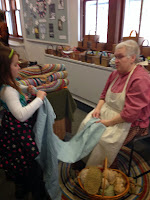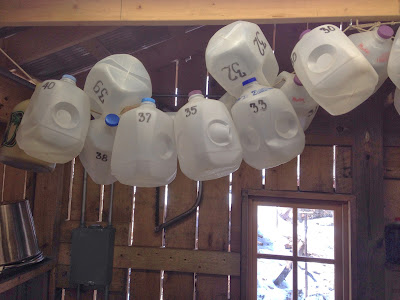There are several areas within Bendix Woods for the event. We started near the historical encampment where we found candle dipping. My kids have done this many, many times so we skipped it, but many children were enjoying it! I know mine have enjoyed it in the past.
While it's neat to see the encampments, I really enjoy talking to the people more as they share information about the time period they represent, how artifacts were used, and bring to life the past.
Inside the building (and elsewhere), I saw the master plan easily on display for people to read and give feedback. I like that they are sharing their direction and vision for the St. Joseph County Parks and also giving people an opportunity to interact with it.
I loved the volunteers! A family was manning the taste test booth. I will say, I got it right! :-) The taste of real maple syrup is distinct and delicious!
The maple cream cheese spread was tasty! I've even taken blocks of cream cheese, covered it with our homemade maple syrup, and sprinkled nuts on top to eat with good bread. Delicious! I liked the cute maple syrup bucket for donations, tapped into the tree!
Several children activities and crafts were available, such as this seasonal tree art and the paper plate dreamcatcher.
Near the Studebaker Clubhouse, there was a tree climbing display. What's with the one eye closed? It's been happening frequently. The older two boys climbed the tree. It took a while to wait for their turn (almost an hour), but they got to use real gear to climb the tree. They both really enjoyed it! I was impressed with the individual care and safety features by the tree arborists.
It seemed like there were ropes and kids everywhere! :-) The arborists were very patient with the kids as they helped them explore one of the Indiana Children's Outdoor Bill of Rights--climb a tree! While waiting for the kids, I was able to meet Evie Kirkwood, host of Outdoor Elements. I enjoy the show and how the program helps connect others with nature! It can be seen online, on the local PBS channel, or I watch it streaming through our Roku. They also have resources linked with each episode and a resource guide. It's a great nature and environmental education service for our area.
The Unity Gardens was nearby with a display of their programs, honey for sale, and crafts.
Others worked on chair caning or making a rag rug. Traditional, natural soaps and bathing products were also shown and demonstrated.
I loved these wooden baskets/boxes with a little leather belt handle!
A metal worker and quilter were also busy at their trades and working their skills.
There was also a display with pictures of sugaring at the camp.
In another area, there were horse drawn carriage rides. They looked popular! Breakfast is also available in the nearby building. Ice carving sculptures and demonstrations are also close.
They also had guided and self-guided tours of the maple sugaring process. We took the guided tour last year, but opted to go on our own this year as some kids were getting a little antsy. I'm sure the tour would have been great again. There are interpretive signs along the path to explain topics such as maple identification, how trees produce food, when it's time to tap, what is sap, the tapping process, what is a sugarbush, etc.
I love their displays! I feel like I am walking back in history.
Different foods used historically are available to see in baskets and other containers.
These molds and other ways of storing and shaping the maple sugar were on display.
Moving forward in time a bit, we saw how early settlers might have made maple syrup, with traditional tools that made the process easier.
The sap was boiling over a fire hung from a tripod. My son tried on a yoke used to help carry the buckets. We also saw earlier wooden buckets and then the galvanized buckets many use today.
Blacksmiths were out working on materials and showing their trade.
Buckets near the top of the hill are emptied into a storage container and then go down to the sugar house through tubing.
The display of milk jugs shows about how many gallons of sap it takes to make one gallon of syrup. It's quite an effective visual! We tapped about 8 trees and just collected a 5 gallon bucket from each--we're expecting about a gallon from what we have but there are some variables
The tubes are all connected to the sugar house--much easier than carrying all those buckets!
The maple sugar kettle corn looked delicious. We had some last year!














































